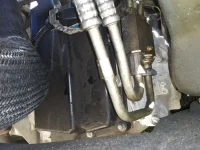2013 Taurus, 270k miles. I'm adding an OEM (PI option) cooler to the car since it's lasted this long, I figure why not help it a bit more? Anyway I have some concerns.
1. I can't tell which line from the trans into the radiator is hot/out, and cool/in. Does it matter where either line goes? Only difference is one is above the other. Both in/out ports on the cooler are on the bottom which is confusing me..
2. The factory cooler is WAY smaller than the radiator. Will bypassing the radiator altogether and only using this cooler affect it negatively, especially in traffic and/or hot weather?
I can post photos if needed. I've looked around but can't find answers to these specific concerns.
1. I can't tell which line from the trans into the radiator is hot/out, and cool/in. Does it matter where either line goes? Only difference is one is above the other. Both in/out ports on the cooler are on the bottom which is confusing me..
2. The factory cooler is WAY smaller than the radiator. Will bypassing the radiator altogether and only using this cooler affect it negatively, especially in traffic and/or hot weather?
I can post photos if needed. I've looked around but can't find answers to these specific concerns.
Last edited:




